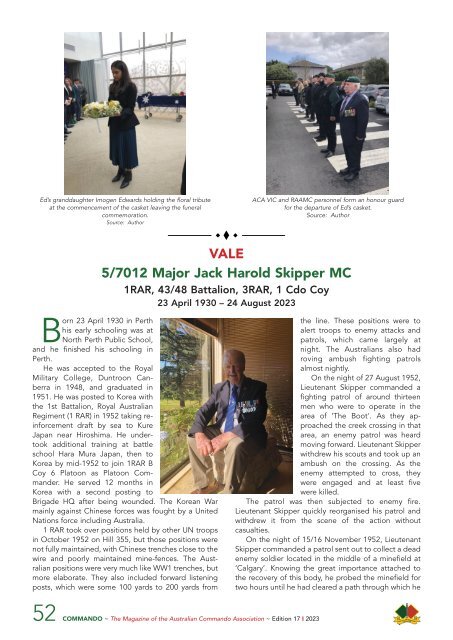Commando Edition 17 2023
The Official Commando News Magazine
The Official Commando News Magazine
Create successful ePaper yourself
Turn your PDF publications into a flip-book with our unique Google optimized e-Paper software.
Ed’s granddaughter Imogen Edwards holding the floral tribute<br />
at the commencement of the casket leaving the funeral<br />
commemoration.<br />
Source: Author<br />
ACA VIC and RAAMC personnel form an honour guard<br />
for the departure of Ed’s casket.<br />
Source: Author<br />
VALE<br />
5/7012 Major Jack Harold Skipper MC<br />
1RAR, 43/48 Battalion, 3RAR, 1 Cdo Coy<br />
23 April 1930 – 24 August <strong>2023</strong><br />
Born 23 April 1930 in Perth<br />
his early schooling was at<br />
North Perth Public School,<br />
and he finished his schooling in<br />
Perth.<br />
He was accepted to the Royal<br />
Military College, Duntroon Can -<br />
berra in 1948, and graduated in<br />
1951. He was posted to Korea with<br />
the 1st Battalion, Royal Australian<br />
Regiment (1 RAR) in 1952 taking re -<br />
inforcement draft by sea to Kure<br />
Japan near Hiroshima. He under -<br />
took additional training at battle<br />
school Hara Mura Japan, then to<br />
Korea by mid-1952 to join 1RAR B<br />
Coy 6 Platoon as Platoon Com -<br />
mander. He served 12 months in<br />
Korea with a second posting to<br />
Brigade HQ after being wounded. The Korean War<br />
mainly against Chinese forces was fought by a United<br />
Nations force including Australia.<br />
1 RAR took over positions held by other UN troops<br />
in October 1952 on Hill 355, but those positions were<br />
not fully maintained, with Chinese trenches close to the<br />
wire and poorly maintained mine-fences. The Aust -<br />
ralian positions were very much like WW1 trenches, but<br />
more elaborate. They also included forward listening<br />
posts, which were some 100 yards to 200 yards from<br />
the line. These positions were to<br />
alert troops to enemy attacks and<br />
patrols, which came largely at<br />
night. The Australians also had<br />
roving ambush fighting patrols<br />
almost nightly.<br />
On the night of 27 August 1952,<br />
Lieutenant Skipper commanded a<br />
fighting patrol of around thirteen<br />
men who were to operate in the<br />
area of ‘The Boot'. As they ap -<br />
proached the creek crossing in that<br />
area, an enemy patrol was heard<br />
moving forward. Lieutenant Skipper<br />
withdrew his scouts and took up an<br />
ambush on the crossing. As the<br />
enemy attempted to cross, they<br />
were engaged and at least five<br />
were killed.<br />
The patrol was then subjected to enemy fire.<br />
Lieutenant Skipper quickly reorganised his patrol and<br />
withdrew it from the scene of the action without<br />
casualties.<br />
On the night of 15/16 November 1952, Lieutenant<br />
Skipper commanded a patrol sent out to collect a dead<br />
enemy soldier located in the middle of a minefield at<br />
‘Calgary’. Knowing the great importance attached to<br />
the recovery of this body, he probed the minefield for<br />
two hours until he had cleared a path through which he<br />
52 COMMANDO ~ The Magazine of the Australian <strong>Commando</strong> Association ~ <strong>Edition</strong> <strong>17</strong> I <strong>2023</strong>
















